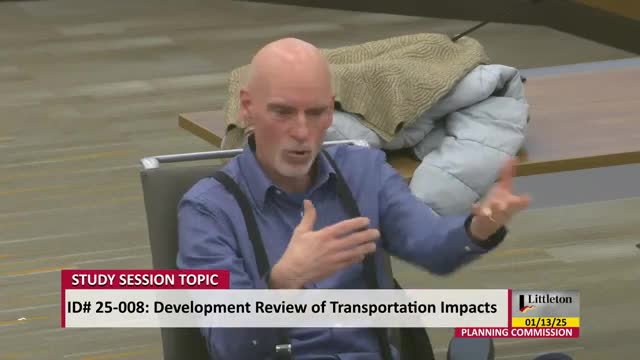Cyclist killed by car prompts call for safer infrastructure on Broadway in Lehi
January 13, 2025 | Littleton City, Arapahoe County, Colorado
This article was created by AI summarizing key points discussed. AI makes mistakes, so for full details and context, please refer to the video of the full meeting. Please report any errors so we can fix them. Report an error »

The Littleton City Planning Commission held a study session on January 13, 2025, focusing on infrastructure improvements and safety measures for various transportation modes within the city. The meeting addressed several key topics, including the need for facilities accommodating low-velocity vehicles, lane width standards, and updates on traffic management policies.
The session began with a discussion about a recent tragic incident involving a one-wheel cyclist who was killed by a left-turning vehicle at an intersection on Broadway. This incident highlighted the urgent need for infrastructure that supports not only traditional vehicles but also low-velocity vehicles, such as bicycles and one-wheels. Commissioners emphasized the importance of creating safe environments for all types of road users to prevent future accidents.
Following this, the commission reviewed proposed cross-section designs for suburban collectors, which are wide roadways intended to accommodate higher speeds. The discussion centered on the necessity of incorporating bike lanes and pedestrian facilities into these designs. It was noted that the right-of-way for these roads is 120 feet, allowing ample space for various transportation options. The commission expressed a desire to ensure that future infrastructure developments reflect a commitment to multi-modal transportation.
A significant point of contention arose regarding lane widths on city streets. The commission debated whether to standardize lane widths at 10 feet, with wider lanes only justified by specific analytical needs. This discussion was rooted in research linking wider lanes to increased vehicle speeds and higher accident rates. The consensus leaned towards establishing 10 feet as the baseline, with exceptions requiring justification.
The meeting also touched on the importance of traffic calming measures, particularly on local streets. Historical references were made to past planning efforts, which successfully implemented narrower lanes to reduce speeds and enhance safety for pedestrians and cyclists. The commission acknowledged that adjusting lane widths could lead to better utilization of roadway space for amenities and improved safety outcomes.
In conclusion, the study session underscored the Planning Commission's commitment to developing a transportation infrastructure that prioritizes safety and accessibility for all users. The discussions will inform future policy updates and infrastructure projects, with a focus on integrating low-velocity vehicle facilities and establishing clear standards for lane widths. The commission plans to continue refining these proposals in upcoming meetings, ensuring that Littleton evolves into a more navigable and safer community for all.
The session began with a discussion about a recent tragic incident involving a one-wheel cyclist who was killed by a left-turning vehicle at an intersection on Broadway. This incident highlighted the urgent need for infrastructure that supports not only traditional vehicles but also low-velocity vehicles, such as bicycles and one-wheels. Commissioners emphasized the importance of creating safe environments for all types of road users to prevent future accidents.
Following this, the commission reviewed proposed cross-section designs for suburban collectors, which are wide roadways intended to accommodate higher speeds. The discussion centered on the necessity of incorporating bike lanes and pedestrian facilities into these designs. It was noted that the right-of-way for these roads is 120 feet, allowing ample space for various transportation options. The commission expressed a desire to ensure that future infrastructure developments reflect a commitment to multi-modal transportation.
A significant point of contention arose regarding lane widths on city streets. The commission debated whether to standardize lane widths at 10 feet, with wider lanes only justified by specific analytical needs. This discussion was rooted in research linking wider lanes to increased vehicle speeds and higher accident rates. The consensus leaned towards establishing 10 feet as the baseline, with exceptions requiring justification.
The meeting also touched on the importance of traffic calming measures, particularly on local streets. Historical references were made to past planning efforts, which successfully implemented narrower lanes to reduce speeds and enhance safety for pedestrians and cyclists. The commission acknowledged that adjusting lane widths could lead to better utilization of roadway space for amenities and improved safety outcomes.
In conclusion, the study session underscored the Planning Commission's commitment to developing a transportation infrastructure that prioritizes safety and accessibility for all users. The discussions will inform future policy updates and infrastructure projects, with a focus on integrating low-velocity vehicle facilities and establishing clear standards for lane widths. The commission plans to continue refining these proposals in upcoming meetings, ensuring that Littleton evolves into a more navigable and safer community for all.
View full meeting
This article is based on a recent meeting—watch the full video and explore the complete transcript for deeper insights into the discussion.
View full meeting
